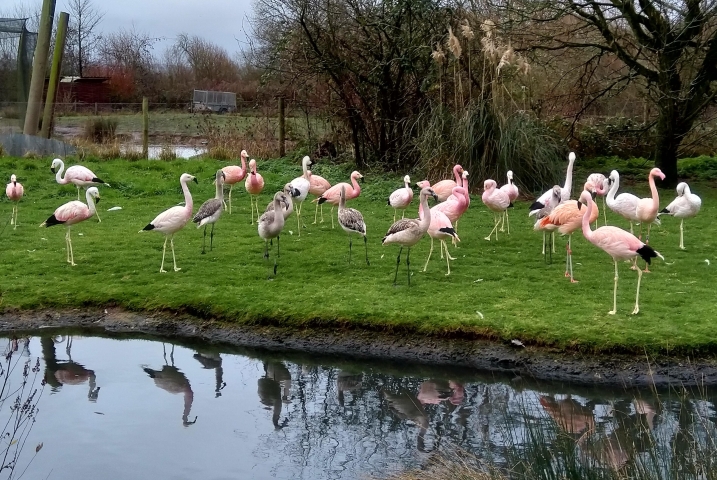Flamingos are flamtastic mothers
Why are flamingos such devoted mothers? What does it take to raise a baby flamingo to adulthood? And why have the parenting behaviours of flamingos made them see in the same way as woodpeckers do? Find out more.
It’s the time of year for Mother’s Day in the UK and in many other countries around the world too. A time to celebrate devoted parents and the special bond that exists between mums and their offspring. As spring arrives at WWT Slimbridge and the other wetland centres that hold flamingos, the birds’ thoughts turn to nesting and the time to dance, find a partner, make a nest and sit on eggs. Flamingos are devoted parents. And flamingo mothers work hard to give their youngster the best start in life. In this Flamingo Diary post we will look behind the scenes at how the WWT birds raise their youngsters and why flamingo mums (and flamingo dads) have to be such devoted parents.
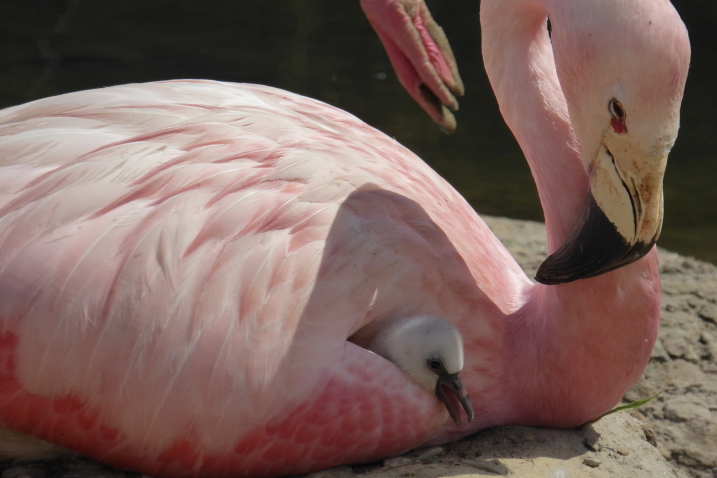
Flamingo mums choose the dad of their future chick by taking part in the famous dance rituals that all six species of flamingo are so famous for performing. When the birds are at their pinkest, the courtship display will be the most extravagant. You can see what I mean in the video of the Caribbean flamingos doing their dancing.
You can spot who might be the next flamingo mothers in the flock by look at the sizes of the birds in the flock. Male flamingos are taller than females. But both dance together. The mums and dads of the future generation both have to decide if they like each other enough to fall in love and make a nest together. Flamingos are very 21st century romantics like that. See if you can spot who’s a potential flaming mum (a shorter female bird) and which ones might be the next flamingo dads (the taller male birds) in this photo of the WWT Slimbridge greater flamingos doing their courtship dance.
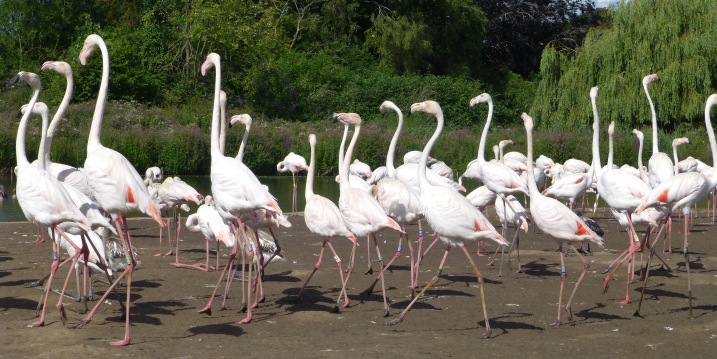
Flamingo mums are choosy about their partner because it takes a long time to raise a flamingo chick and they need help with nest building, incubation and feeding the new arrival. Flamingos live for a long time but don’t always nest successfully every year. So each potential flamingo mother can afford to be as picky as possible when it comes to deciding on who to nest with.
Because flamingos are irregular nesters and so they have to “get it right” and all produce chicks when they can nest, their anatomy and way of feeding also dictates their parental care responsibilities. Flamingos have a very specialised feeding behaviour and the shape of their bill takes many weeks to develop.
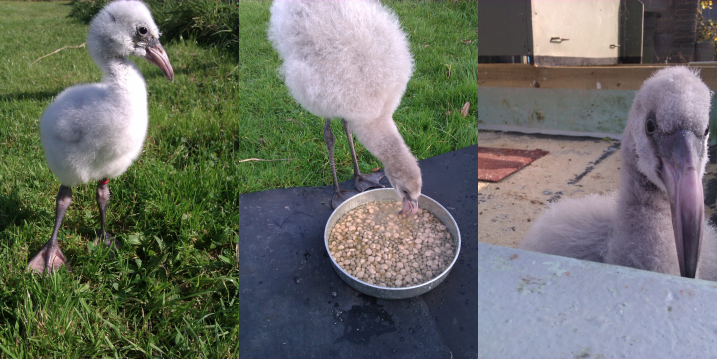
In the photo above you can see a bird of a week or so old (with a straight bill), and then as the bird ages and starts to get taller, so the bill becomes more curved. This curve is important because it is the shape of the bill that means the flamingo can collect food by filtering. Young flamingo will practice filtering for food, middle photo, but cannot completely feed themselves whilst they are still covered in down. Photos kindly provided by Phoebe Young.
Until the young bird has grown the right shaped bill and perfected the filtering behaviour (how the adult flamingo sieves food from the water) it is dependent on its mum and dad for food. That’s why both parent flamingos produce what is known as “crop milk”. A secretion made in the flamingo’s throat that is fed directly from the parent’s bill into the chick’s bill. Parent flamingos have to feed their chicks like this because the chick is not capable of feeding itself properly, even though they start trying to filter feed from an early age- they are simply not equipped with the right tool for the job.
The feeding of “crop milk” has influenced the evolution of flamingo eyesight. So a flamingo mother can accurately feed her chick, she can focus her vision precisely on the end of her bill, meaning she can then place her bill into that of her chick, allowing her to feed it this valuable crop milk with very little wastage. Flamingos have the same visual field (i.e. the area that they can see around their head) as precision pecking birds, like woodpeckers. This baffled scientists for many years, until it was realised it was because of this need for dribbling food from the parent’s beak into the chick’s beak.
When a flamingo egg is laid, Phoebe and her team will check, after a few days, the fertility of the egg to see if it’s likely to produce a chick. Phoebe shins a light from a candling torch into the egg (this does no harm to any developing embryo) to look for the development of blood vessels. If the egg is fertile, in around 30 day’s time, it will hatch into a fluffy grey bundle.
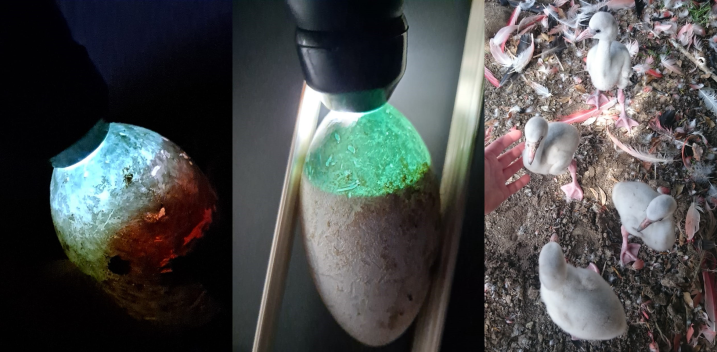
In the image above you can see eggs being candled check their fertility. Flamingo eggs have a white shell that is covered in a chalky outer layer, which you can see in the middle photo. If the egg is fertile, a month later, a fluffy grey chick will emerge. Photos kindly provided by Phoebe Young.
Phoebe and the other living collections staff monitor the baby flamingos on their nests to check they are feeding well and that mum and dad are coping with the demands of having a new baby to care for. Chicks are weighed and measured and health checked to keep an eye on their growth and development. Flamingo mums (and dads) keep feeding their chick for about 12 weeks. By this point, the chick’s bill will be curved into the same shape as its parents and the grey down has been replaced by brown/grey immature feathers. Over the period of the next four to five years the chick will get pinker and pinker until it finally has the same feather colour as mum and dad.
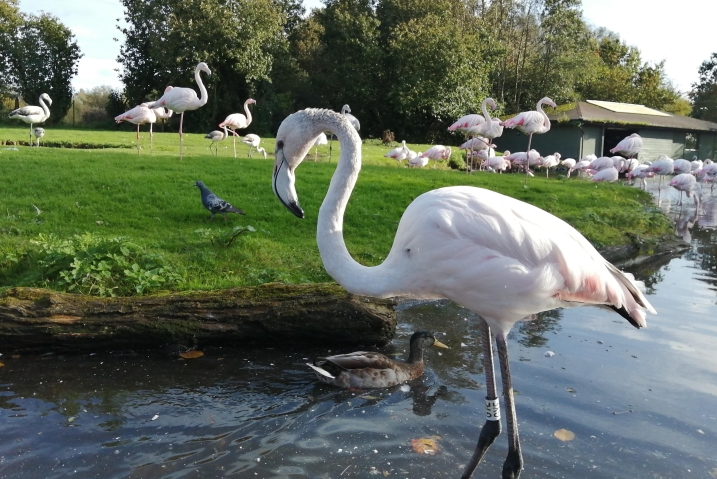
The photo above is of a young greater flamingo at WWT Martin Mere. It's around a year and a half old. The pink wing feathers are coming through and its grey baby feathers are restricted to its neck. It's legs are brightening in colour and so is its bill. In the far back left is a younger bird, coming up to a year old. This much darker grey all over, with few pink feathers growing through.
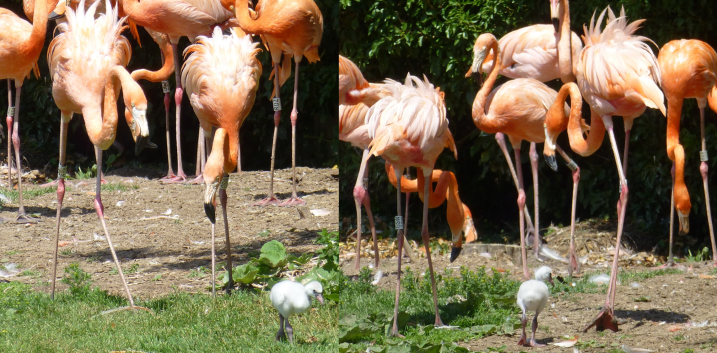
Two of my favourite flamingo photos from doing my research at WWT Slimbridge. A newly-off-the-nest Caribbean flamingo chicks decides to go for a wander and gives its parents the run around, who diligently follow before finally coaxing it back to the main colony. Flamingo parents are patient parents!
You can look out for the hard working mums at the end of summer as these will be the adult birds that are pale. The efforts of taking part in raising a chick literally draining them of their pinkness. Spot the parents (the white birds) compared to the brighter pink colour of those flamingos that didn't breed in the photo below. It will be a few months before mums and dads recover to moult into more colourful feathers, ready for their next chance to raise a chick.
Happy Mothers Day to all the mothers, grandmothers and those have have been like a mum out there.
